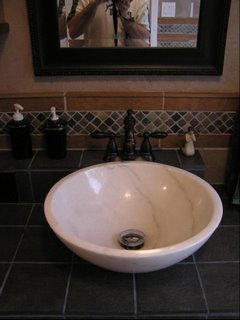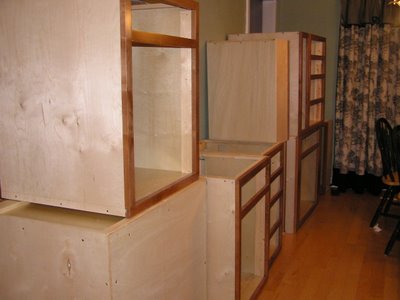Here are the steps for installing the granite...
Make sure the wood surface is totally flat. I used a
block plane to make sure every bump and imperfection in the plywood was planed flat. I pay close attention to where pieces of plywood come together.

I built a small fixture to set the overhang of the granite. The granite is made of 1/2" plywood (the granite is 1/2"), with three peices of tape to add a slight additional thickness for the glue

Dry fit the tiles first, start in the corner and work out. With these large tiles, the best way to get a good corner is to do a miter as shown, and put an 18x18 in the corner.
 Apply polyurethane glue in line 1" appart.
Apply polyurethane glue in line 1" appart.

Install the tiles. The corner is the toughest, since you need to get the overhange right on both sides. This would be really hard to do with the fixture.
Once the tiles are in place, tape them together so they don't drift around as the glue foams and expands. Clamp the front across the joint to make sure everything is even.

Continue to install the tiles. I needed to slightly shim a few of them, since they are not exactly the same thickness everywhere. These had about a 1/16 variation. Since the glue foams up and expands to fill space, I could just shim the corners at the glue takes care of the rest.
If I needed to clamp the tiles in a back (a couple of spots), I put something heavy on them, like a 25 pound box of screws.

I kept the joints really tight, basically butting the tiles next to each other. The chamfer in the tiles will give a 1/16" joint, which will get filled with epoxy grout. The picture shows that the joints are already almost invisible, and once grouted will blend right in.

The glue needs to set for four hours - in this case overnight. Tomorrow I put the front lip on.
[Click here for photo set]
 Our granite has been installed for about a year now, and we still really like it. I would do this again the same way, and we consider it a "must do" for the kitchen.
Our granite has been installed for about a year now, and we still really like it. I would do this again the same way, and we consider it a "must do" for the kitchen. 















 I built a small fixture to set the overhang of the granite. The granite is made of 1/2" plywood (the granite is 1/2"), with three peices of tape to add a slight additional thickness for the glue
I built a small fixture to set the overhang of the granite. The granite is made of 1/2" plywood (the granite is 1/2"), with three peices of tape to add a slight additional thickness for the glue 
 Apply polyurethane glue in line 1" appart.
Apply polyurethane glue in line 1" appart. 















